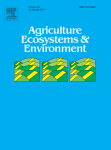
Open-burning of rice straw residues pollutes the air and contributes to global warming through emissions of greenhouse gases (GHGs). Although burning of straw residues emits large amounts of CO2, this component of the smoke is not considered as net GHG emissions and only concludes the annual carbon cycle that has started with photosynthesis. Hence, we focused on emissions of CH4 and N2O from open-field burning against a baseline of straw incorporation. The experimental approach combined a newly designed combustion chamber for the collection of smoke followed by chemical analysis (Exp. A) as well as field observations of soil-borne emissions for different straw treatments (Exp. B). At constant straw moisture of 10%, the mass-scaled Emission Factors (EFm) were 4.51 g CH4 and 0.069 g N2O per kg dry weight (kg−1dw) of straw. In Exp. B, we conducted field trials over two seasons with the following straw management practices: SRt − straw retained including stubbles and incorporated, PSRm − partial straw removal only stubbles incorporated, CSRm − complete straw removal including removal of stubbles, and SB − straw burned followed by incorporation of ash and unburned residues. Soil-borne emissions were recorded with a closed chamber approach whereas straw burning was computed indirectly using the EF from Exp. A. As metrics for comparison, we have used the GWP contributions of CH4 and N2O for the different straw management practices over two cropping seasons in the field. On an annual basis, SRt had the highest total GWP (8023 kg CO2eq ha−1). SB entailed a GWP of 4913 kg CO2eq ha−1 that was almost identical to the GWP of PSRm (4531 kg CO2eq ha−1). CSRm had the lowest GWP (3470 kg CO2eq ha−1) that was significantly lower than that of SRt. However, full GHG accounting of straw removed from the field will depend on the ensuing utilization of straw and the off-field emissions involved − which was outside of the boundaries of this study. The quantification of open field burning in this study can be instrumental for diverse purposes by providing data of an important component in emission inventories and carbon footprint analysis of rice.








